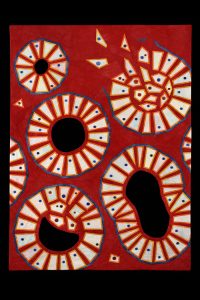Enter your address to receive notifications about new posts to your email.
Articles by Guest Author (138 results)
-
GSA-Art: Shruthi Vembar
Guest post by Shruthi Vembar. GSA-Art features the creative works of scientists. Read more in GSA President Stan Fields’ call for submissions. If you would like to submit your own work or nominate someone else’s, please send an email to GenesToGenomes@genetics-gsa.org with “GSA-Art” in the subject line. Madhubani painting, also known as Mithila painting, is an art form that originated in Northern…
-
GSA-Art: Bonny Brewer
Guest post by Bonny Brewer. GSA-Art features the creative works of scientists. Read more in GSA President Stan Fields’ call for submissions. If you would like to submit your own work or nominate someone else’s, please send an email to GenesToGenomes@genetics-gsa.org with “GSA-Art” in the subject line. I have been in love with DNA for as long as I can remember.…
-
GSA-Art: Sean Burgess and Larissa Miyachi
GSA-Art features the creative works of scientists. Read more in GSA President Stan Fields’ call for submissions. If you would like to submit your own work or nominate someone else’s, please send an email to GenesToGenomes@genetics-gsa.org with “GSA-Art” in the subject line. Guest post by Sean Burgess. Chromosome letters is a short novel that follows two young DNA strands, Tabellarius and…
-
Memories of Sue Lindquist
Guest post by Christine Queitsch. Last week when the scientific community lost one of its brightest and most innovative minds, I lost my long-time mentor and the closest thing to a mother since I lost mine. Susan Lindquist had found me in a basement laboratory in the former East Germany, in 1992, shortly after the…
-
GSA-Art: Biswapriya Misra
GSA-Art features the creative works of scientists. Read more in GSA President Stan Fields’ call for submissions. If you would like to submit your own work or nominate someone else’s, please send an email to GenesToGenomes@genetics-gsa.org with “GSA-Art” in the subject line. Biswapriya Misra is a postdoc in the Department of Genetics at the Texas Biomedical Research Institute. He loves cooking and…
-
GSA-Art: Joanne Topol
Guest post by Joanne Topol. GSA-Art features the creative works of scientists. Read more in GSA President Stan Fields’ call for submissions. If you would like to submit your own work or nominate someone else’s, please send an email to GenesToGenomes@genetics-gsa.org with “GSA-Art” in the subject line. My art reflects inner feelings that cannot be accessed through analytic thought. These feelings are…
-
GSA-Art: Bianca Ruiz
GSA-Art features the creative works of scientists. Read more in GSA President Stan Fields’ call for submissions. If you would like to submit your own work or nominate someone else’s, please send an email to GenesToGenomes@genetics-gsa.org with “GSA-Art” in the subject line. Bianca Ruiz is a graduate student rotating in the Fields lab at the University of Washington, Genome Sciences, who…
-
GSA-Art: Barbara Shih
GSA-Art features the creative works of scientists. Read more in GSA President Stan Fields’ call for submissions. If you would like to submit your own work or nominate someone else’s, please send an email to GenesToGenomes@genetics-gsa.org with “GSA-Art” in the subject line. To me, science is not about being in the lab; it is about solving puzzles. I have been working…
-
GSA-Art: Matthew Sachs
GSA-Art features the creative works of scientists. Read more in GSA President Stan Fields’ call for submissions. If you would like to submit your own work or nominate someone else’s, please send an email to GenesToGenomes@genetics-gsa.org with “GSA-Art” in the subject line. Our first GSA-Art post is by Matthew S. Sachs, a Professor in the Department of Biology at Texas A&M University…
-
Guest post: An interview with Denis Duboule
Guest post by Teresa Bonello It was 1984 and the first cloning of the homeobox sequence in Drosophila had just been reported. Newly-minted postdoc Denis Duboule was called into the office of his mentor, Pierre Chambon, and asked if he wanted to lead his own investigation looking for Hox clusters in mice. What followed was…
-
Trying to Find your Way in the Nervous System? C. elegans can help!
Guest post by Daniel G. Taub. With billions of neurons in the human brain, making the right connections during development seems a daunting task. A developing neuron often follows the lead of trailblazers, using existing bundles of axons called axonal tracts as a guide. But how does the original axonal tract get laid down? In…











